Got questions about 2 ohm and 4 ohms speakers & subwoofers? You’re in the right place!
Dig in as there’s a ton of great info and clear & helpful diagrams, too!
Contents
- Which is best – 2 ohm or 4 ohm subwoofers?
- 2 ohm vs 4 ohm load amplifier power comparison
- How do I know what my amp’s minimum speaker Ohm rating is?
- Important note about bridging an amp for subwoofer use
- Using multiple subwoofers in series vs parallel
- What about dual voice coil subwoofers?
- 4 ohm vs 2 ohm car speakers
Which is best – 2 ohm or 4 ohm subwoofers?
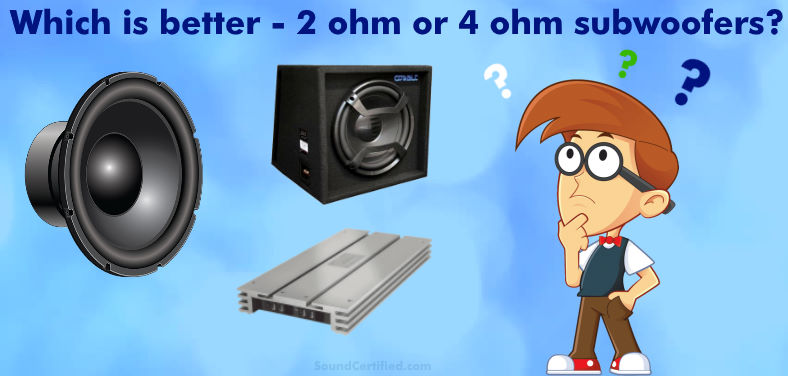
The basic answer is that you should use the subwoofer impedance best matched to your amplifier when possible. An amplifier will produce the most power it is capable of at the correct Ohm load it’s designed for.
The end result is you’ll get the most power for your money when matching the minimum impedance to the amp.
- For a 2 ohm amp with its maximum power at 2 ohms, use a 2 ohm subwoofer or 2 ohm total speaker load when using multiple speakers.
- For a 4 ohm amp with maximum power at 4 ohms, use a 4 ohm subwoofer or 4 ohm total speaker load with several speakers.
With the same power delivered to each, a 4 ohm speaker and identical 2 ohm speaker will produce the same amount of volume. The problem is that each one will affect how much power you’ll get.
2 ohm and 4 ohm speakers aren’t really “better” than one another – it depends on how they’re used, the amplifier, and some other details I’ll cover as we go.
**Note: It is true that a low impedance speaker will draw twice the electrical current of one with a higher impedance but there’s a good reason for that as I’ll explain.
(Note that the Ohm symbol (Ω) is commonly used to represent units of resistance or impedance.)
What is the difference between a 2 ohm and a 4 ohm subwoofer?
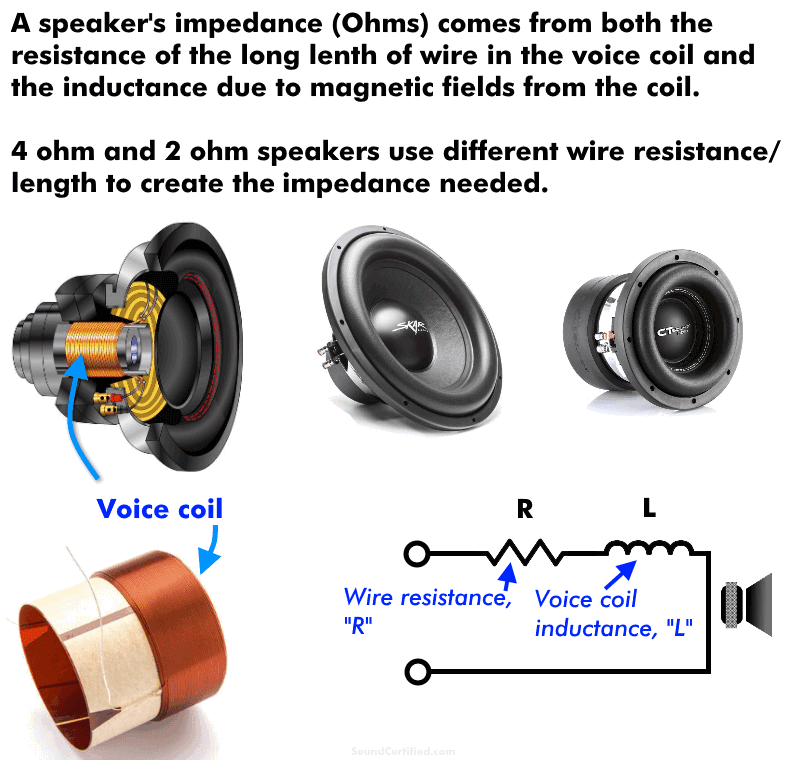
2 ohm and 4 ohm subwoofers are the same but use a different impedance (total resistance) voice coil or pair of coils.
There are 2 ways to get high power in a vehicle with a +12V electrical system:
- Increase the voltage used to deliver power to the electrical load: a car amplifier uses a step-up internal power supply to create higher voltages than the vehicle has in order to deliver more power.
- Lower the resistance of the load (speaker impedance). 2 ohm voice coils make this possible when an amplifier can’t provide as much power to a 4 ohm coil subwoofer.
In the case of dual voice coil (DVC) subwoofers, a pair of 2Ω coils allow you to get a 4Ω speaker load if needed as they can be connected in series with speaker wire.
They’re really handy when changing amplifiers, bridging an amp, or using more speakers together as you’ll have flexibility in the wiring option.
2 ohm vs 4 ohm load amplifier power comparison
DIAGRAM – 4 ohm vs 2 ohm subwoofer amp power
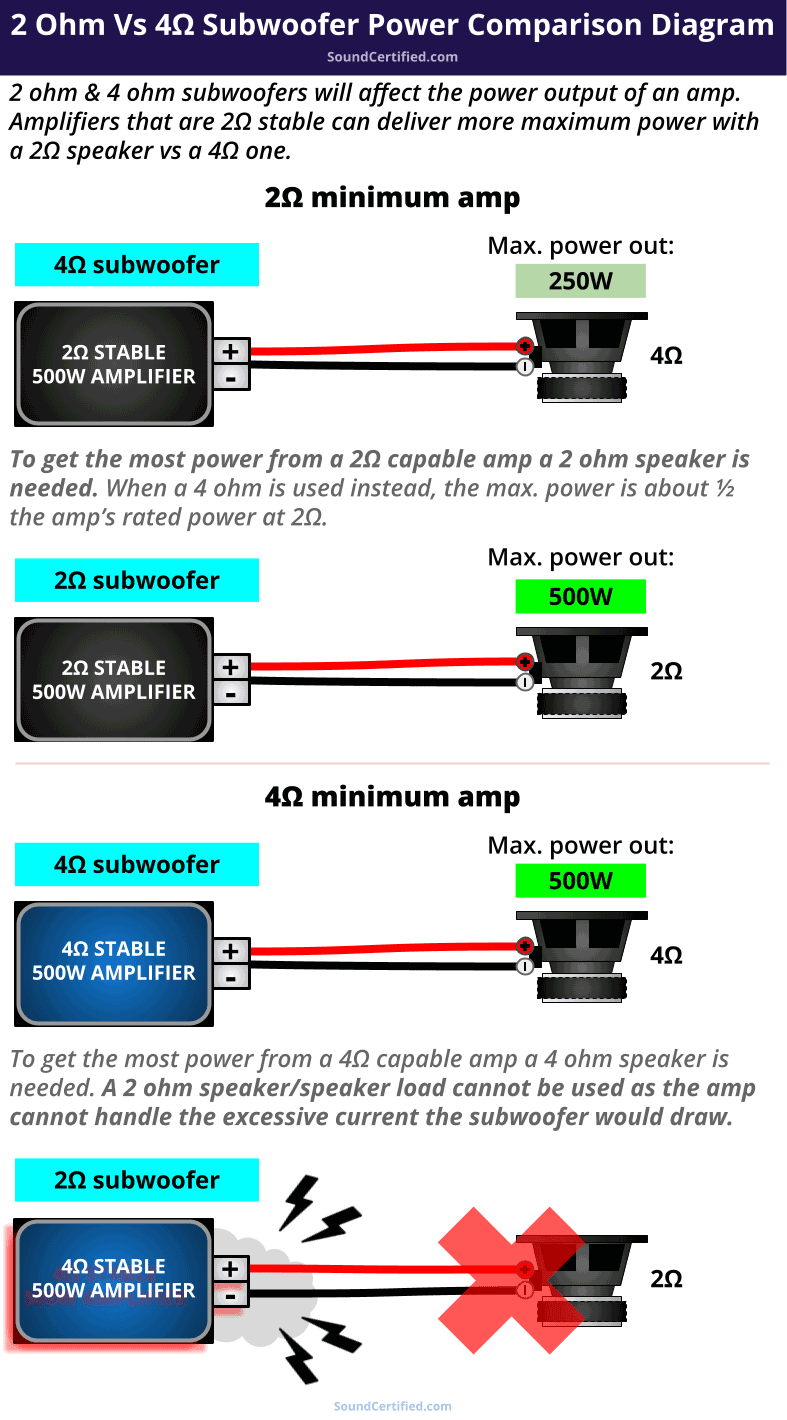
The reason why you get the best results with a 2 ohm or 4 ohm subwoofer matched to your amp is due to the relationship between voltage, power, current, and resistance.
If you’re not familiar with Ohm’s Law or Watt’s Law, they’re simple ways to remember the relationship between the electrical resistance, voltage, and current. When combined and re-arranged we have a simple formula we can use to calculate power to an electrical resistive load like a speaker.
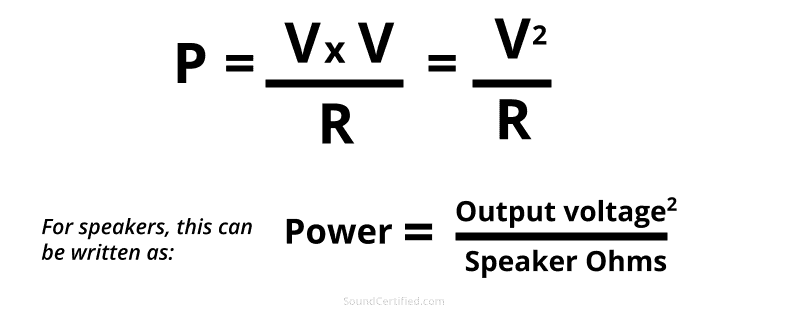
Why the right subwoofer Ohm load is important for amplifier power
Car audio stereos or amps and home stereos create power to a speaker by boosting (amplifying) the tiny musical source signal to a higher voltage that can overcome the speaker’s resistance.
For your home audio system it’s not much of problem powering an 8 ohm speaker, however, cars & trucks don’t a high voltage available to make that possible.
Voltage, power, and speakers
The more voltage that can be output, the more current that be sent and therefore more power and louder sound. The issue is that each device (radio, amplifier, etc.) has a limit to how much it can put out.
This means that a higher speaker Ohms load will decrease the current, and just as you would expect, this means less power can be delivered to a speaker.
To get the most power your amplifier can provide it’s important to match the subwoofer Ohm load to the amp’s min. Ohms rating specified. There’s nothing “wrong” with using a higher speaker impedance, but you’re not going to get the power you paid for.
How do I know what my amp’s minimum speaker Ohm rating is?
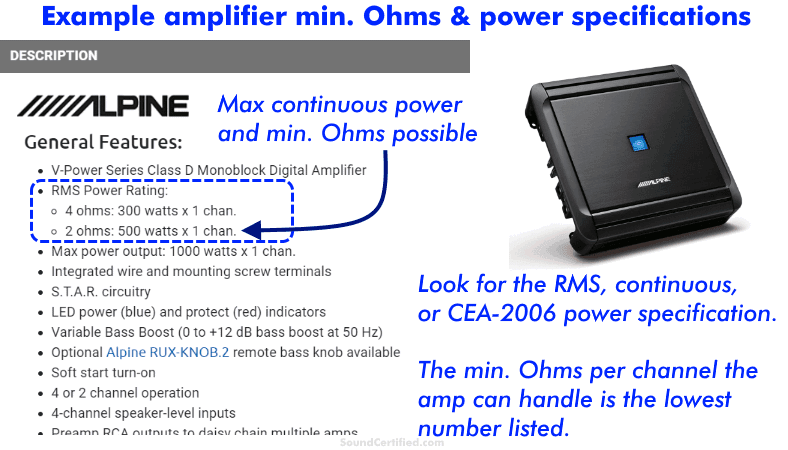
An amp’s power specifications should be provided by the manufacturer, retailer, and so forth. It’s normally listed both on the package and in the owner’s manual.
Here are some important things to pay attention to:
- The maximum power rating to use is the RMS, continuous, or CEA-2006 power rating provided. “peak power” or “maximum” or not what you’re looking for.
- Unfortunately, many manufacturers still list outrageous and misleading power numbers for their products. RMS is the power spec based on what an amp can produce reliably and continually.
- The Consumer Electronics Association (CEA) created the CEA-2006 standard to help buyers know a product lives up to its advertised specs. Look for that as it’s a reliable set of specs, usually from the better manufacturers.
- The minimum Ohms rating an amp can handle, also called the Ohms it’s “stable to”, is the smallest number listed per channel. This also depends on the channel mode (stereo, bridged, etc.).
Important note about bridging an amp for subwoofer use
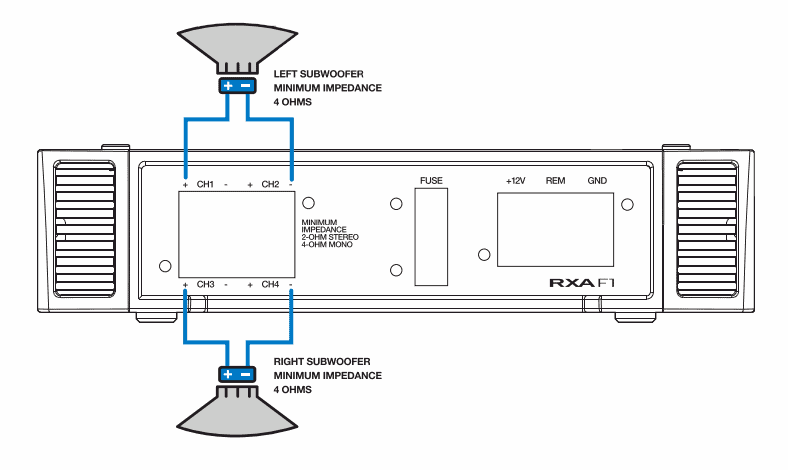
One thing to bear in mind before buying subwoofers is that nearly all bridgeable 2 channel or 4 channel amps require a minimum of 4 ohms in bridged mode.
This is due to how bridging works. While many of today’s amps can handle down to 2Ω per channel, bridging works but using 2 channels together in a push-pull fashion to deliver more power.
For that reason, the 4Ω requirement is due to the total of both channels’ min. Ohms load.
Using multiple subwoofers in series vs parallel
DIAGRAM – Series vs parallel subwoofer power comparison
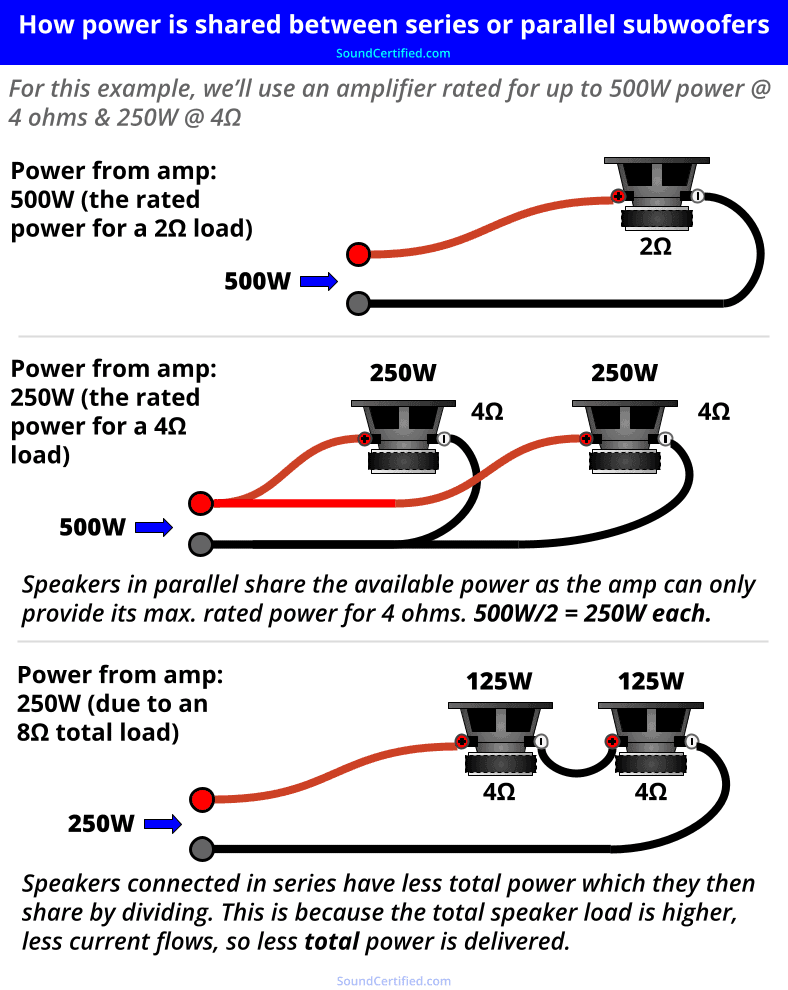
When hooking up multiple speakers you can’t get free power – connecting two speakers or more speakers to one output channel means they will have to share the available power.
The way you go about doing that, and the total impedance, is very important.
Remember these basics:
- Parallel speakers share the output power for the total speaker load. For example, connecting two 4Ω speakers in parallel means a total of 2 ohms. Each speaker would then get 1/2 of the amp’s rated power output at 2 ohms.
- Series connected speakers receive less power overall because the total power to all is lower than parallel speakers. For example, two 4 ohm speakers in series add to an 8 ohm total load. Power output at 8 ohms is 1/2 that of 4 ohms, with each speaker having 1/2 of that.
When connecting 2 or more speakers to one output channel it’s a compromise you have to live with. A car amplifier is often designed with one or two speakers per channel in mind.
I get a lot of questions and comments from readers who are trying to use speakers that can’t be wired well to get the most power from their amp.
Take my advice: plan ahead and work out the speaker ohms and single voice coil or DVC details before you but the speakers and/or the amp.
What about dual voice coil subwoofers?
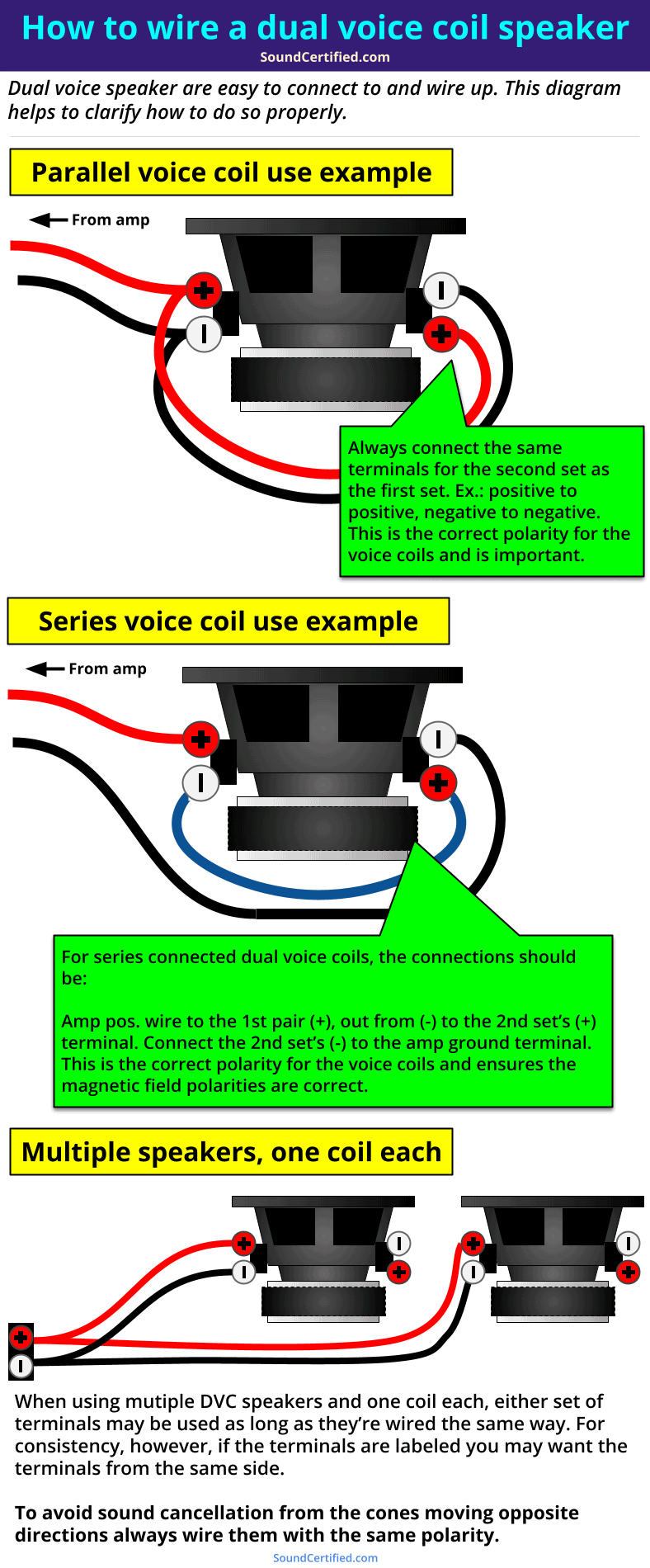
Dual voice coil subwoofers are also an option. They’re also handy in case you change your audio system later or want to switch things up.
To get the best results you’ll want to remember a few things:
- When possible, buy or use DVC subwoofer impedance that will allow you to wire all coils in parallel to their channel. This will allow you to get a lower impedance to match the amp’s min. Ohms load.
- DVC subwoofers can be used with only one voice coil when necessary but it’s not ideal. Their parameters are not quite they same and they cannot handle the same amount of heat or power as they can if both are used.
- Mixing different Ohms rating DVC subwoofers rarely works out well. Most of the time you can’t get the right overall impedance. It’s often too high or too low to be optimal and in many cases some voice coils won’t be used.
- You can use one amp channel per voice coil if necessary. However, ideally you’ll use a mono (non-stereo) input to both of the amp’s RCA inputs. This is so both channels have the same signal and avoids any differrences that can cause sound cancellation.
As long as you’ve correctly bought (or have on hand) the correct ones you can get a 4 ohm load, 2 ohm load, or even 1 ohm load as needed. When using a mono amp this can be a bit trickier if you’ve got more than 2 subwoofers.
**Note: many car stereos or signal processors provide a mono signal from the subwoofer RCA outputs, making it easy to drive one voice coil per channel.
4 ohm vs 2 ohm car speakers
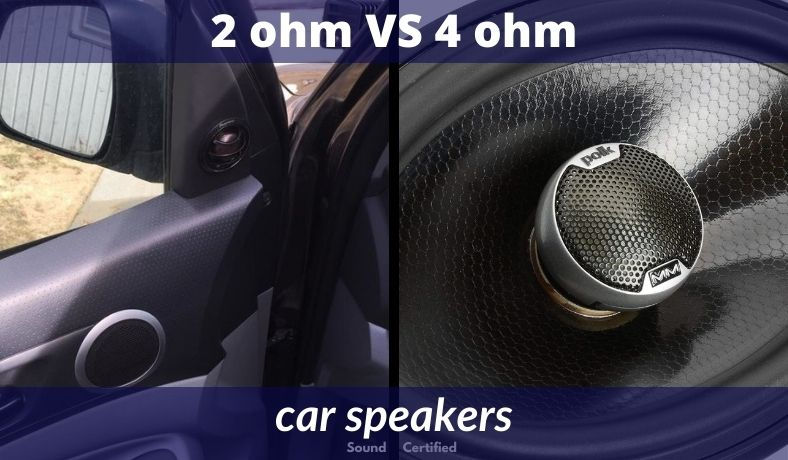
There are some 3 ohm and even 2 ohm coaxial, woofer, and component speaker sets available one the market. While it may be tempting to buy those instead of a standard 4Ω car speaker for full range music, here are some considerations to consider:
- You won’t be able to bridge amp channels (4Ω min.) in order to get more power. I recently had a reader contact me and unfortunately he’s stuck without a way to avoid this aside from using a higher impedance speaker set.
- You won’t be able to use tweeters or another set of speakers in parallel. If you’re tight on space, money, or need to wait on buying a second amp this can be a roadblock. Many people use a 2Ω min. amp to drive two speakers in parallel, such as tweeters and coaxial speakers. Buying a lower impedance means that’s not going work.
If your amp offers more power per channel at 2Ω to your main speakers, go for it. But remember you’ll need a dedicated channel for each speaker.
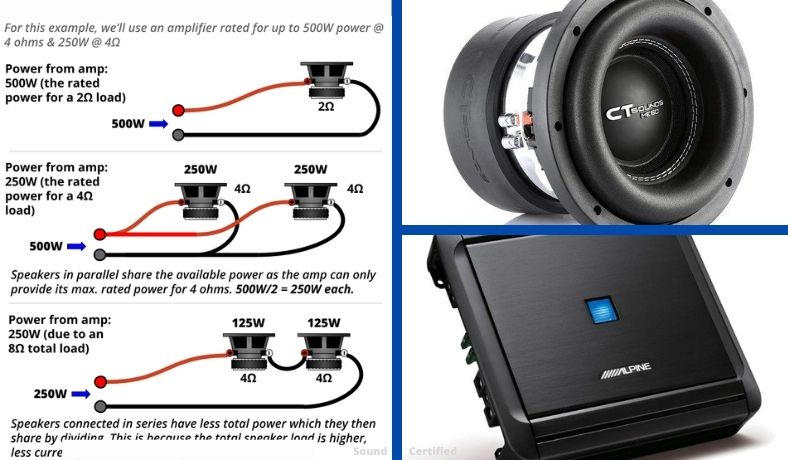

Marty,
Having a very hard time finding a 2 ohm DVC 5.25 in subwoofer for a replacement in my 2000 BMW Z3 sub box. I wanted to find a sub that I could use the factory harness. Do you have any suggestions on speaker company’s that would make such a replacement? If I can’t find a 2 ohm DVC replacement what would be my options for a 5.25 in size sub?
I am not a big bass enthusiast but I think the car needs some bass. Was maybe thinking about a DVC mid range/bass speaker as an option. Again I would want to use the factory harness so I would need a DVC option.
Would appreciate any help and guidance you could provide.
Thanks,
Glenn
Hi Glenn. Yes unfortunately specialty subwoofers are hard to deal with. Here are some possible ideas:
1. If the original subwoofer still works but the speaker surround foam is dry-rotted and fell apart, you may be able to use a reconing/repair service or do it yourself. I saw kits online for this woofer, I think.
2. You could use a standard 2Ω 5.25″ woofer and then use a stereo to mono adapter like this one. This one is rated for 30 watts.
3. You could use a small 2-channel amplifier in bridged mode and connect it to the factory subwoofer wiring (via a speaker level to line level adapter). Then you can power a standard 4Ω woofer of your choice. In bridged mode the output will be L + R channels combined, so you won’t lose part of the audio signal versus connecting a single voice coil directly to the factory wiring.
I did find a Dayton Audio 4Ω DVC 5.25 subwoofer (this one here) but unfortunately the magnet structure is far too large I think.
Another good idea would be to search the BMW / Z3 owner’s forums, as you may find some posts showing what other vehicle owners did in the same situation. Hopefully this helps a bit!